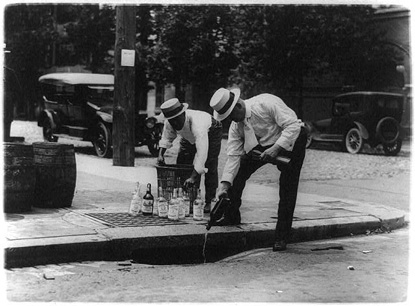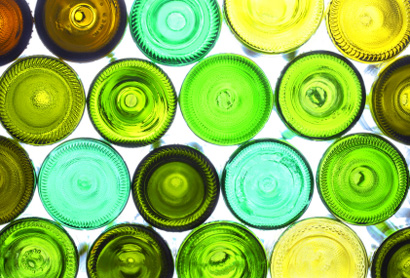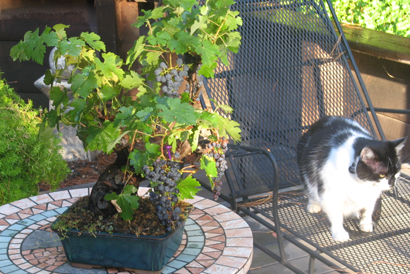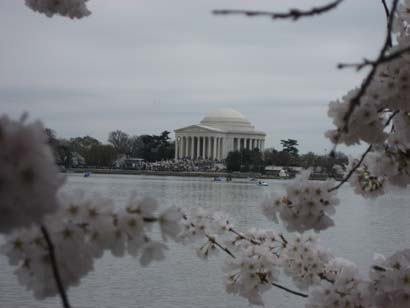Dr Vino's wine blog
wine talk that goes down easy
Repeal of Prohibition, age 74

On this day, December 5, in 1933, they partied like it was 1999.
Prince wasn’t even born, tech stocks hadn’t been invented, and the dreaded Y2K bug hadn’t yet terrorized the land. No, 74 years ago today, wine, beer and spirits flowed freely for the first time in fourteen years as the ratification of the 21st Amendment ended Prohibition. Can you imagine–fourteen years of a (legally) dry country? [shudder]
You can read more about how this complicated period affected the story of American wine in my forthcoming book, Wine Politics: How Governments, Environmentalists, Mobsters and Critics Influence the Wines We Drink.
Until then, let’s raise a glass in honor of having the ability to do so–providing you’re over 21, of course.
By complete coincidence, one friend wrote me yesterday saying that he had just enjoyed a bottle of 1933 Justino Malmsey Madeira (find this wine), saying it was “really, really good…still had enough acidity for another 74 yrs.” Now that’s toasting in style.
After the jump, find a list of bars in NYC that are celebrating Repeal tonight. In the comments, post bars in your city that you know of or any plans you have for tonight. Read more…
Now is the time for California cheap wine–will producers drop the ball again?
 Gisele Bundchen doesn’t want our dollar any more. Jay-Z flashes a wad of 500 euro notes in his latest video. Jim Rogers, former parter of financier George Soros, is selling his house and all assets in the US dollar and moving to Asia.
Gisele Bundchen doesn’t want our dollar any more. Jay-Z flashes a wad of 500 euro notes in his latest video. Jim Rogers, former parter of financier George Soros, is selling his house and all assets in the US dollar and moving to Asia.
I was stuck on a local subway yesterday when I should have been on the express. That gave me time to flip all the way to page C14 of the WSJ and read the currency table and see what’s got Gisele, Jay-Z, and Rogers running for the hills. Not a pretty picture. The greenback is down across the board: -10% against the euro YTD, -12% against the australian dollar, -7.6% against the kiwi dollar, and even -4.7 against the Chilean peso. (Trivia: which significant wine producing country has the dollar actually appreciated against this year?) Elsewhere I read that the euro has appreciated by 50% since 2002 against the dollar.
Thanks to our dollar looking like the currency of a banana republic, imported wines are getting more expensive. Who stands to gain? Why, producers in America since we’re in the same, downtrodden currency zone together.
Paging California! Will you please answer the white courtesy phone? This is your moment to shine. Start making interesting wine under $10. Imported wine often has to go through one more tier (the importer) than your wine so there’s a built-in cost advantage. Now with the declining dollar, that gap widens.
Imported wine has grown to account for almost a third of all wine in America, up from only 13% in 1990. The Silicon Valley Bank ripped California a new one in a report last spring as they stared in awe at the whirling vortex of Yellow Tail, pinot grigio, and Chilean cab: “Are American vintners starting to look like Detroit in the 70’s, when gas prices soared and automakers kept putting out big gas guzzlers?”
But their same report this year suggested an American market of strengthening demand and short domestic supply. They predicted foreign wineries to fill the gap. But at some point in the dollar’s decline, the importers and the producers will stop sharing the pain and pass it on to the consumer in the form of higher prices. I talked with Bill Deutsch, importer of Yellow Tail, a few years ago and know that he is a savvy currency hedger. But with hedging, you can run for a while but you can’t hide forever.
Sadly, rising prices for foreign wines just means less competition for California. And as we wine consumers know all too well, a lack of competition too often means a rise in prices or a decline in quality. That would be a sad direction for them to go.
Hit the comments if you have had a stand-out wine under $10 from California (or elsewhere in the US). Not that Gisele and Jay-Z are interested. But some of the rest of us in this currency zone are.
(Image: victoriassecret.com)
Calculating the carbon footprint of wine: my research findings

Is that a whiff of raspberries and leather you get from that red wine–or a whiff of petroleum? With some premium wines consuming three times their weight in petroleum, don’t be surprised if it is the latter.
My previous postings on the carbon footprint of wine made me want to determine just how much carbon is involved in the making and transporting of our favorite beverage. So I collaborated with Pablo Paster, a sustainability metrics specialist, and we ran the numbers. Our findings have just been published as a working paper for the American Association of Wine Economists, available here as a pdf.
While I welcome your comments on the whole paper, I’ll post some of the key findings here:
* Organic farming has lower greenhouse gas (GHG) intensity than conventional farming but I was surprised that the difference wasn’t greater. Clearly there may be other differences in a local ecosystem but the GHG difference was surprisingly small. But on the whole, it was the transportation that played a more significant role from a GHG perspective.
* Regarding the “food miles” debate, we find that distance does matter.
* But not all miles that a bottle travels are the same. Efficiencies in transportation make container ships better than trucks, which in turn are better than planes.
* Shipping premium wine, bottled at the winery, around the world mostly involves shipping glass with some wine in it. In this regard, drinking wine from a magnum is the more carbon-friendly choice since the glass-to-wine ratio is less. Half-bottles, by contrast, worsen the ratio.
* Shipping wine in bulk from the source and bottling closer to the point of consumption lowers carbon intensity.
* Light packaging material such as Tetra-Pak or bag-in-a-box has much less carbon intensity.
* Using oak chips is a more carbon friendly alternative than oak barrels, particularly those that are shipped assembled and empty around the world
* There’s a “green line” that runs down the middle of Ohio. For points to the West of that line, it is more carbon efficient to consume wine trucked from California. To the East of that line, it’s more efficient to consume the same sized bottle of wine from Bordeaux, which has had benefited from the efficiencies of container shipping, followed by a shorter truck trip. In the event that a carbon tax were ever imposed, it would thus have a decidedly un-nationalistic impact.
What does this mean for the green wine consumer? Drinking a wine made without agrichemicals, from larger format bottles, or wine that has traveled fewer miles is the more “green” option. Beyond these points (or in addition to them), you could perform your own carbon offsets, for example, by giving up one bottle for another and saying no to bottled water.
“Red, White and “Green”: The Cost of Carbon In the Global Wine Trade,” By Tyler Colman and Pablo Paster
UODATE: This paper was been published in the March 2009 issue of the Journal of Wine Research
image 1: istockphoto.com
Federally funded grape research? It’s peanuts
A “CBS Evening News with Katie Couric” story is shocked, shocked! to learn that $11 million of “your tax dollars” have been allocated to conduct research on wine grapes including a $2.6 million research facility at Cornell.
But they have it wrong: it’s not shockingly bad news, it’s new news. And it’s good news.
Ever since the repeal of Prohibition, the federal government has been reluctant to fund grape research. In fact, in the 1930s, after Repeal, FDR’s Department of Agriculture proposed a wine research facility to be funded with federal funds and help the industry get back on its feet. However, an influential Dry congressman unilaterally vetoed the project wanting to prevent the evil “fermentation.” Since then the federal government has been reluctant to fund wine grape research.
So this $11 million should be seen as a real breakthrough, evidence that the federal government is actually doing something to support wine. With over 5,000 licensed wineries now in the US according to Wine Business Monthly, wine and related grape growing is a rapidly growing sector of American agriculture. For what it’s worth, the industry is very consolidated with the top 30 wine producers making over 90% of the wine. If this funding is going to support the proverbial 4,970 “little guys,” then that is something that would be hard to oppose. CBS, however, does not discuss who will benefit most from this research funding.
In the name of fair and balanced reporting, CBS News should look at other research facilities, such as the National Research Peanut Laboratory. Or how much in federal funds are used in subsidies to field crops such as wheat and corn in the $280 billion (five year) Farm Bill. Or the federal budget overall, now $3 trillion. A subsidy of $11 million in this age of private equity chieftains even seems small by some individual standards. In the federal budget, it’s smaller than a rounding error.
Related: “Groundbreaking for Cornell University’s western New York grape laboratory: Oct. 29“
Start your vineyard one bonsai vine at a time

We’ve all thought about starting a vineyard–come on, a few sips of a fine wine and you start to fantasize about living a life surrounded by vines and with a cellar of fine wine. And then the next morning cold reality sets in.
Well, now there’s an affordable way to get one vine closer to that goal. The Sonoma Winegrape Commission is selling “bonsai” cabernet sauvignon vines that even bear fruit. Larry, who works for the organization, told me that they get the vines for free and that all the proceeds benefit vineyard worker education. He also sent along the above picture of his own one-vine vineyard. Guard cat not included.
Washington DC is the thirstiest non-state in America!

Yesterday, several readers of this site showed off just how smart they are by rapidly answering the question about which state consumes the most wine in America. In fact, it was a trick question because it is our nation’s capital, Washington, DC that holds the state wine-drinking crown. But it’s not even a state! New Hampshire is the thirstiest state in America with both taxation and representation. Congratulations to Alex on guessing DC and JB for being Jill on the spot with her guess of New Hampshire.
The rate of wine consumption is 7.79 gallons per adult per year for DC and 6.29 for NH according to Adams Wine Handbook 2006. Although those figures are way above the national average of 3.09 gallons per adult American, they are still below France, which has about 14 gallons per person.
For some local perspective on why Washington is at the top of the charts, I spoke this morning with Scott, the general manager at the wine store Schneider’s of Capitol Hill. Read more…
Which state drinks the most wine per capita?
 Steve Heimoff asked about per capita rates in last week’s wine trivia question. So this week I give you the biggest question of them all: which state has the highest wine consumption per capita? (population over 21)
Steve Heimoff asked about per capita rates in last week’s wine trivia question. So this week I give you the biggest question of them all: which state has the highest wine consumption per capita? (population over 21)
Answer and data source will be revealed in 24 hrs. Until then, the comments are open. Go for the glory and be the first to answer correctly. And go for the double bonus points if you can also guess the correct amount (gallons per adult per year).
Sonoma in New York, October 3
Have you ever tasted true, pre-winemaker terroir? How about a comparative tasting of wine grapes?
Such a tasting is possible next week in New York City–with grapes harvested just two days prior in Sonoma and FedExed in. It’s part of an evening October 3 at the NYU Torch club called “Sonoma winegrape harvest celebration” organized by the Sonoma Winegrape Commission, the James Beard Foundation, and New York University’s School of Continuing and Comparative Studies.
The event will open with a reception including four Somona cheeses (including the yummy Cowgirl creamery) and three wines. Then I’ll moderate a discussion about the diverse area and harvest update from winemaker Joel Peterson of Ravenswood and winegrape grower Jim Murphy. Then Jim will lead us in the just pick’d grape tasting–two flights of four kinds of red grapes!
Sonoma-based chef, Bruze Riezenman, will then lead the group in a food and wine pairing. The event concludes with another casual tasting of five wines and Chef Riezenman’s small plates.
In all, there will be thirteen wines, red and white, from Sonoma–and eight types of grapes! Check out the 2007 harvest, without jet lag.
October 3, NYU. Registration and details.
(image from sonomawinegrape.org)





